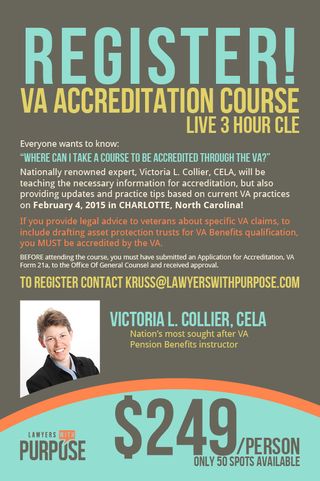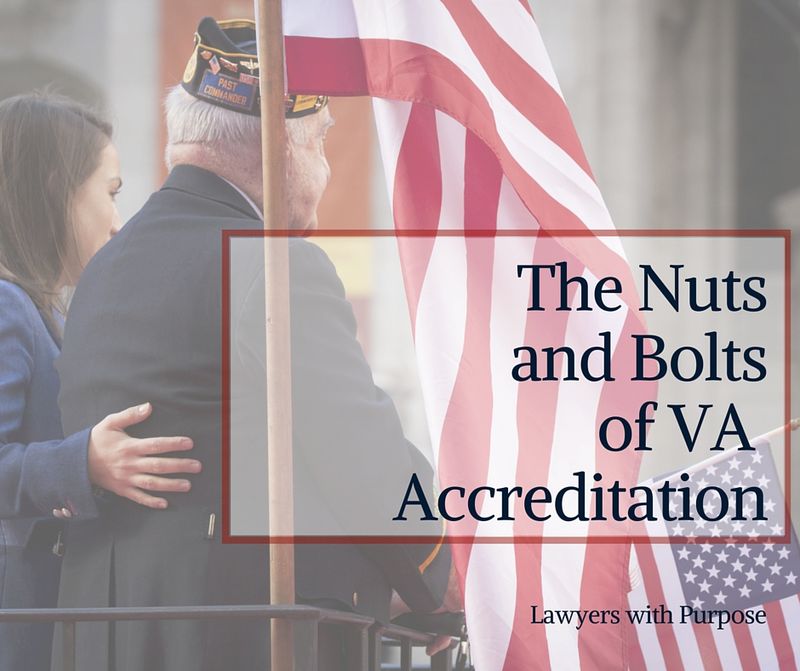There are three categories of individuals whom the VA will accredit: representatives of VA-recognized Veterans Service Organizations (VSOs), independent claims agents, and private attorneys. The route to accreditation differs for these various categories, but the governing department of all accreditation matters is the VA’s Office of General Counsel (VAOGC). It is this department that handles any questions, comments, and requests for correction of information related to accreditation as well as receiving any complaints regarding misconduct or incompetent representation.
The Wisdom of Never Giving Assets to the Kids
Invariably, in every workshop I have presented to clients over the last 10 years, I've been asked the question, “When should I give my house (or other assets) to the kids?” My answer is quick, swift and with a smile: “Never. In fact, you never want to give anything to anyone you love.”
 That usually gets their attention and draws a frown – until I explain. Giving assets to your children defeats the very thing the client is often attempting to accomplish. When I ask why they want to give their assets to the kids, the response 99 percent of the time is that they want to protect the assets. I respond, so the way you protect your assets from your creditors and predators is to give it to your kids so those assets are subject to all their creditors and predators? Who has more creditors and predators, you or your kids? And then I get the blank stare.
That usually gets their attention and draws a frown – until I explain. Giving assets to your children defeats the very thing the client is often attempting to accomplish. When I ask why they want to give their assets to the kids, the response 99 percent of the time is that they want to protect the assets. I respond, so the way you protect your assets from your creditors and predators is to give it to your kids so those assets are subject to all their creditors and predators? Who has more creditors and predators, you or your kids? And then I get the blank stare.
The key element when doing asset protection planning from general creditors and predators, or for Medicaid eligibility and long-term care, is to be properly informed of the options available. Not only can transfers in assets to the kids subject your assets to risk by the kids' bankruptcy, divorce, lawsuits, and even your child's death, but it could have adverse income tax consequences.
Transfers to children are at a “carry over” tax basis to them; that is, they inherit the asset at what you paid for it. This could be extremely detrimental in the case of highly appreciated assets. In fact, it creates an income tax on sale that would not otherwise have been due, had the client held it to death and then transferred it to the children. The key point is to know how to get the best of both worlds.
That's where the IPUG™ protection trust is so essential. The Irrevocable Pure Grantor Trust™ allows the grantor to be the trustee, to benefit from the trust (to the extent they so desire while understanding the impact) and to be able to change their beneficiaries or any other provisions they desire. This is very empowering to clients who traditionally believe once you create an irrevocable trust, you can't change it, you can't benefit from it, and you can't control it.
In fact, you can do all three; it's just in how you do it. The core distinction in an IPUG™ trust is that you must give up only what you want to protect. For example, if you want to protect your assets, you must give up, forever, the right to own those assets. But you do not have to give up the right to control those assets, manage those assets or even get the beneficial interest and use of those assets! The most common way grantors benefit from their assets that they no longer can reach is by living in the house they have transferred to an IPUG trust, or by continuing to maintain receipt of the income and dividends from any cash investments or brokerage accounts in which they have put inside the IPUG™. Most people realize they don't really need the assets; they just need the income produced from them and want to maintain control.
For those who do need access to their assets, they are not candidates for the use of the IPUG™, or any other protection trust. They would use a typical revocable living trust, which accomplishes their estate planning needs and can provide asset protection after death. That's why you never want to give the money to the kids after you die either. One of the greatest advantages seniors have is, after death, the ability to transfer their assets to their children in a trust that the children can control and benefit from any time they want – but creditors or predators can never invade those assets, for the life of the child! This includes the government, lawsuits, divorces, bankruptcies, and even nursing homes.
The money is flat-out safe.
Why would anyone give anything to anyone they love when they can give it to an IPUG trust that protects it for them while they're alive and for their children for their lifetimes after they're gone.
If you aren't a member of Lawyers With Purpose and want to know more about what we have to offer (which is tons of technical legal support) for your estate or elder law practice, register for our Having The Time To Have It All webinar on Thursday, July 23rd at 2 EST. Reserve your spot today to learn more about creating the practice of your dreams.
David J. Zumpano, Esq, CPA, Co-founder Lawyers With Purpose, Founder and Senior Partner of Estate Planning Law Center
What To Do With A Denied VA Application – Part 2
In a prior blog titled, “What To Do With A Denied VA Application – Part 1" I discussed what you should consider when a VA application is denied and the merit of pursuing an appeal despite the time it can take to prevail. Today’s blog will describe the appeal process as initiated by the Notice of Disagreement (NOD), the formal way to submit a claimant’s disagreement with a VA determination. While a Notice of Disagreement can be drafted in the form of a letter or on a 21-4138, “Statement in Support of a Claim,” there is an official VA 21-0958, “Notice of Disagreement” form that was introduced in 2013. The latest 2015 version of this form can be found at the VA Forms web page http://www.va.gov/vaforms/.
 As of March 24, 2015, this form is required to appeal a Service Connected Disability claim, but it is not required to appeal a Non-Service Connected Disability claim. The terms of the form suggest that it is geared more towards service-connected disability claims; however, it can be used for non-service-connected disability claims as well.
As of March 24, 2015, this form is required to appeal a Service Connected Disability claim, but it is not required to appeal a Non-Service Connected Disability claim. The terms of the form suggest that it is geared more towards service-connected disability claims; however, it can be used for non-service-connected disability claims as well.
Once you have timely filed the NOD, which is within one year from the date on the initial decision letter, the VA will respond with a letter requesting that you select what form of the appeal process you prefer. There are 2 forms of the appeal process at this stage: the Post Decision Review Process and the Traditional Appeal process. You must make this election within 60 days from the date on this letter or your appeal will default to the Traditional Appeal process. The Post Decision Review Process involves the assignment of a Decision Review Officer (DRO) at your regional VA office who will completely review the claims folder as well as any information from the authorized representative. The Traditional appeal process is a review by a VA staff member at the pension management center. In either case, more information may be requested. The Post Decision Review Process is the preferred appeals method as it make be quicker than the Traditional Appeal Process and relies on the greater expertise and experience of the Decision Review Officer to identify adjudication errors.
Regardless of which appeals process you elect, the next step would receiving either an approval or, if not approved, a Statement of the Case (SOC). The SOC is an often, lengthy statement summarizing the VA’s decision and the evidence on which the decision was based as well as providing relevant legal citations. To continue the appeal after receiving the SOC, you must file VA form 9, “Appeal to Board of Veterans’ Appeals” within 60 days from the date of the Statement of the Case. At this level you have the option of requesting a hearing before the BVA, although this will easily extend the processing of your appeal beyond 3 years to 5, or even 7, years depending on the form of hearing.
The appeal process is not difficult in terms of what you need to fill out and when you need to file it. The difficulty lies in managing a process where long periods of time are spent waiting for a response from the VA, punctuated by whirlwinds of activity when you must request and receive information and documentation from your client to draft and submit a response to the VA within a short period of time, regardless of what else may already be on your desk. That is why it is important that your client inform you of any correspondence that they may receive in case you do not receive a copy and that deadlines are scheduled in your firm management system so that they are not missed. Such precautions are the only way to increase the likelihood that your appeals will succeed.
If you want to learn more about Veteran Benefits Planning for you estate and elder law practice, join us June 1st – 3rd for our Practice With Purpose Program. It will teach you not just all you need to know about VA Benefits, but also Asset Protection Planning and Medicaid Planning!
If You Practice in Today's Estate Planning Environment, You Won't Want to Miss This!
By Sabrina A. Scott, Paralegal, The Elder & Disability Law Firm of Victoria L. Collier, PC and Production Coordinator for Lawyers for Wartime Veterans, LLC.
Victoria L. Collier, Veteran of the United States Air Force, 1989-1995 and United States Army Reserves, 2001-2004. Victoria is a Certified Elder Law Attorney through the National Elder Law Foundation, Chair, National Academy of Elder Law Attorney’s VA Task Force, Author of 47 Secret Veterans Benefits for Seniors, Author of Paying for Long Term Care: Financial Help for Wartime Veterans: The VA Aid & Attendance Benefit, Founder of The Elder & Disability Law Firm of Victoria L. Collier, PC, Co-Founder of Lawyers With Purpose, LLC.
Tips On Calculating Payments From IRAs
Many practitioners inquire whether the Social Security actuarial tables or the IRS minimum distribution tables should be used when determining the required minimum distribution (RMD) of an IRA to ensure their client qualifies for Medicaid. So what is the proper tables to use?
 In typical lawyer fashion, the answer is, it depends. 42 USC Section 1396(b)(c)(1)(G)(ii) provides for annuity to be actuarial sound, and not considered an uncompensated transfer, the annuity must pay out over the life expectancy of the annuitant "in accordance with the actuarial publications of the Office of the Chief Actuary of the Social Security Administration." The same is true when determining the proper payout on a promissory note or mortgage as outlined in 42 USD 1396p (c)(1)(I). How does this differ from the required minimum distribution tables published by the Internal revenue service and what is the relevance?
In typical lawyer fashion, the answer is, it depends. 42 USC Section 1396(b)(c)(1)(G)(ii) provides for annuity to be actuarial sound, and not considered an uncompensated transfer, the annuity must pay out over the life expectancy of the annuitant "in accordance with the actuarial publications of the Office of the Chief Actuary of the Social Security Administration." The same is true when determining the proper payout on a promissory note or mortgage as outlined in 42 USD 1396p (c)(1)(I). How does this differ from the required minimum distribution tables published by the Internal revenue service and what is the relevance?
Sections 401, 403, and 408 of the Internal Revenue code outlines requirements regarding retirement accounts. Upon attaining age 70½ required minimum distributions are required under the tax laws is based on the RMD tables published. In comparison, the Social Security tables are very different, and in some circumstances the IRS tables require nearly half the RMD that the Social Security life expectancy tables require. So how do you be certain which one you use?
To keep it simple, to remain compliant with the tax laws, the IRS tables must be utilized in determining the required minimum distribution to avoid any adverse tax penalties for failing to withdraw the minimum amount required. Medicaid and benefits planning, however has a different standard is that the Medicaid law specifically refers to the Social Security Administration table in determining the actuarially sound calculation of any annuity owned by a Medicaid applicant.
So the proper table to use will depend not on the law, but on which table your Medicaid department uses. While the law is clear that it requires the Social Security tables, many states allow the IRS RMD tables and some states even exempt an annuity if the IRA is simply in a "payout status. Once you are clear on how your state identifies an “actuarially sound” annuity or promissory note, you will have your answer. So, one final responsibility is to ensure when the Social Security tables are used, the amount required to be withdrawn is equal to or more than the minimum amount required by the IRS RMD tables. That ensures a client’s benefits’ planning is also tax compliant. Conversely, if a client is not doing benefits planning, then relying on the IRS RMD tables may result in a lower minimum distribution requirement.
If you are not a Lawyers With Purpose member, and would like to know more about who we are and the benefits we can bring to your estate and elder law practice, join our FREE Having The Time To Have It All webinar Monday at 8:00 PM EST.
Dave Zumpano, Esq, CPA, Co-founder Lawyers With Purpose, Founder and Senior Partner of Estate Planning Law Center
How To Know When An SNT Needs A Tax ID Number
The question among many practitioners is, does a supplemental needs trust need a separate tax I.D. number and have to file a separate income tax return? The answer is, it depends. So let's examine when an SNT needs a separate tax I.D. and when it doesn’t.
 A supplemental needs trust will be a first party or third party trust. A first party supplemental needs trust is funded with assets of the disabled individual who is also the beneficiary of the trust. Under law a first party supplemental needs trust can only be created by the parent or grandparent of the individual, or a court. Once the first party supplemental needs trust is created, it will not require a separate tax I.D. number, but instead will use the tax I.D. number of the disabled beneficiary. All income earned by the first party supplemental needs trust will be reported on the income tax return of the disabled beneficiary, but will not affect or be counted toward their continuing eligibility, as long as distributions are made on the beneficiary’s behalf and not made directly to the beneficiary.
A supplemental needs trust will be a first party or third party trust. A first party supplemental needs trust is funded with assets of the disabled individual who is also the beneficiary of the trust. Under law a first party supplemental needs trust can only be created by the parent or grandparent of the individual, or a court. Once the first party supplemental needs trust is created, it will not require a separate tax I.D. number, but instead will use the tax I.D. number of the disabled beneficiary. All income earned by the first party supplemental needs trust will be reported on the income tax return of the disabled beneficiary, but will not affect or be counted toward their continuing eligibility, as long as distributions are made on the beneficiary’s behalf and not made directly to the beneficiary.
A third party supplemental needs trust is created and funded by someone other than the disabled beneficiary, but for the benefit of a disabled beneficiary. Whether a tax I.D. number is required for the third party SNT will depend upon how the trust is structured. In most third party SNT’s, the creator of the trust (grantor) wishes to maintain control of the trust for the benefit of the disabled beneficiary. In this case, no separate tax I.D. number would be required as it would be considered a "grantor" trust and all income would be taxed to the grantor. If the grantor is not the trustee, but retains other identified rights, then the same rules would apply. Alternatively, if the grantor creates a trust and retains no rights to change it, benefit from it or control its distribution, then it may be a non‑grantor trust and need a separate tax identification number.
Similarly, after the grantor who created the trust and retained rights to make it a grantor trust dies, the third party supplemental needs trust now becomes a "non‑grantor trust" and requires a separate tax identification number. Annual income tax returns would have to be filed for non-grantor SNT’s but the actual tax will be deemed payable by either the beneficiary, or the trust, depending upon the actual distributions made. For example, if a supplemental needs trust earned $10,000.00 in a year, and they used $7,000.00 of it for the beneficiary, it would "pass through" the $7,000.00 in taxable income to the beneficiary on a Form K1. The remaining $3,000.00 retained in the trust, would be taxed at the trust tax rate and payable by the trustee directly with the tax return filed by the trust with the IRS. Finally, in relation to IRAs, the IRS has ruled in Private Letter Ruling 200820026, that an IRA payable to a supplemental needs trust at the death of the IRA owner, will not be required to be liquidated and, but instead, the age of the disabled beneficiary will be used for "stretch purposes" and it will be considered a grantor trust of the beneficiary for purposes of the IRA distribution.
So does a supplemental needs trust need a tax I.D. number? No and yes it all depends how you create the trust during lifetime and how you plan for it!
If you are interested in learning more about estate planning and more specifically on the iPug Business Planning, join us February 12th at 8 EST where we'll talk about:
- Learning the difference between General Asset Protection, DAPT Protection, Medicaid Protection and iPug® Protection
- Comprehensive outline of the 2 primary iPug® Business Protection Strategies
- Learn why clients choose single purpose Irrevocable Pure Grantor Trusts™ over LLCs
- Learn how it all comes down to Funding
And much much more… Click here to register now!
David J. Zumpano, Esq, CPA, Co-founder Lawyers With Purpose, Founder and Senior Partner of Estate Planning Law Center
How To Plan For The Home The Right Way
A major question comes up often during estate planning for seniors in determining what to do with the primary residence. There are many choices, but the actual selection will depend heavily on the ultimate goal of the client. Typical client goals include basic estate planning, probate avoidance, home management in the event of incompetency, benefits planning (Medicaid/VA), asset protection planning, and estate and income tax planning. Let's review strategies in each of these situations.
 The most common form of ownership of the primary residence by a husband and wife is as tenants by the entirety or similar legal ownership. By state law, this provides asset protection during life as 100 percent of the property will convey to the surviving spouse without any liens attached by a deceased spouse’s liabilities. Obviously for single individuals no asset protection is provided and non-spousal joint tenancy may protect the assets for the surviving joint tenant, subject only to Medicaid and IRS's right to recovery. The most typical funding strategy is to transfer the primary residence to a revocable living trust (RLT) to avoid probate. Some states also allow payable-on-death deeds (ladybird deeds) or heirship deeds. While funding the home to a revocable trust or these other strategies avoid probate and could provide post death asset protection (RLT), they do not effectively provide protection "during life".
The most common form of ownership of the primary residence by a husband and wife is as tenants by the entirety or similar legal ownership. By state law, this provides asset protection during life as 100 percent of the property will convey to the surviving spouse without any liens attached by a deceased spouse’s liabilities. Obviously for single individuals no asset protection is provided and non-spousal joint tenancy may protect the assets for the surviving joint tenant, subject only to Medicaid and IRS's right to recovery. The most typical funding strategy is to transfer the primary residence to a revocable living trust (RLT) to avoid probate. Some states also allow payable-on-death deeds (ladybird deeds) or heirship deeds. While funding the home to a revocable trust or these other strategies avoid probate and could provide post death asset protection (RLT), they do not effectively provide protection "during life".
Another primary strategy is to convey the home to an irrevocable trust. These are typically done when clients are interested in estate tax savings or asset protection. The primary question relates to whether the irrevocable trust is a "grantor trust" or a "non-grantor trust” for tax purposes. Traditionally, estate tax reduction trusts are non-grantor trusts and the home would maintain its "carry over tax basis" to the beneficiaries of the trust thereby creating a capital gains tax on the difference between the sales value and the original price paid by the grantor who conveyed it to the trust. In contrast, a grantor trust that retains rights that include the value of the irrevocable trust in the estate of the deceased grantor, would receive a "step up" in basis after the death of the grantor. While these serve estate and income tax needs, they often may conflict with benefits planning, such as for Medicaid and/or veterans' benefits. In addition, one must be cautious in conveying a principle residence to a RLT or irrevocable trust as it could defeat any real property tax exemptions. The client is eligible for when the property is owned in the client’s name. You need to confirm with your local assessor on the impact of the credits upon funding the home to the trust chosen.
Medicaid and veterans' benefits, on the other hand, have additional restrictions above and beyond the tax and legal restrictions regarding trusts. Putting a personal residence in an irrevocable trust for Medicaid can provide asset protection during lifetime but doing so creates a uncompensated transfer which affects future eligibility. Another question in funding the personal residence is whether to retain a reserved life estate in the deed and convey the remainder to the trust or to convey the whole residence to the trust and maintain a right for the grantor to live there inside the trust document. This is often avoids the loss of any real property tax credits but if the home is sold during the grantor’s lifetime, then the grantor's pro rata ownership (lifetime interest) proceeds would be considered “available” in determining the grantor's ongoing Medicaid eligibility.
In contrast to Medicaid planning, planning for VA benefits has additional considerations. A veteran can convey their home to an irrevocable “grantor” trust without consequence. The caution, however, is if the residence is sold during the grantor's lifetime and converted to an income producing asset (cash, stocks, ect.) it would thereafter trigger the asset value in determining the veteran's future benefit eligibility.
Planning for the home appears simple but is absolutely essential that the overall client goal is identified before determining where to fund the home. Understanding these strategies are essential.
If you would like to learn more about irrevocable trust (iPug Trust) join our FREE webinar Thursday, February 12th at 8 EST click here to register now. During this webinar you'll discover:
- Learn the difference between General Asset Protection, DAPT Protection, Medicaid Protection and iPug® Protection
- Comprehensive outline of the 2 primary iPug® Protection Strategies
- Learn why clients choose single purpose Irrevocable Pure Grantor Trusts™ over LLCs
- Learn how it all comes down to Funding
Click here to register. We'll see you then!
David J. Zumpano, Esq, CPA, Co-founder Lawyers With Purpose, Founder and Senior Partner of Estate Planning Law Center
How To Distinguish The Snapshot Date From The Look Back Date
Many lawyers doing Medicaid qualification for their clients often get confused between the snapshot date and lookback date. These dates are not only confused by lawyers, but also often by the Medicaid departments processing the application. So let's set it straight. 42 US 1396r-5 (c) states the snapshot date occurs on the first day of the month in which a Medicaid applicant reached thirty days of "continuous institutionalization". Continuous institutionalization is identified as thirty consecutive days in an institution of care. These include hospitals, nursing homes, VA facilities, or the like.
 If an individual enters a hospital on January 15, is discharged on January 30, enters a nursing home on February 5, and applies for Medicaid on March 1, no snapshot date has occurred. Why? It's simple. Thirty continuous days of institutionalization has not occurred by March 1. By virtue of the discharge from the hospital on January 30 and readmission to the nursing home on February 5, a lag occurred, restarting the 30 day period. Since they entered the nursing home February 5, and applied March 1, no snapshot date is set because thirty continuous days has not occurred.
If an individual enters a hospital on January 15, is discharged on January 30, enters a nursing home on February 5, and applies for Medicaid on March 1, no snapshot date has occurred. Why? It's simple. Thirty continuous days of institutionalization has not occurred by March 1. By virtue of the discharge from the hospital on January 30 and readmission to the nursing home on February 5, a lag occurred, restarting the 30 day period. Since they entered the nursing home February 5, and applied March 1, no snapshot date is set because thirty continuous days has not occurred.
Continuing, if the client stays in the nursing home through March 5, then the snapshot date would be February 1, the first day of the month in which the applicant entered a facility for thirty days of continuous institutionalization. The significance of the snapshot date is it represents the date Medicaid will look at all financial assets owned by the Medicaid applicant and spouse in determining whether or not they are eligible for benefits. In this case, Medicaid would take a "snapshot" of all assets owned by the applicant and spouse on February 1 and use this information to determine the client's individual resource allowance, the community spouse resource allowance, and the client's net available monthly income that can be used for the cost of care.
What makes all this confusing is, although the federal statute is clear as outlined above, most states treat the “lookback date”, as the "snapshot date." The lookback date is entirely different; it is the date when applicant resides in a nursing home AND applies for Medicaid benefits. In this case the lookback date does not occur until the Medicaid applicant applies for Medicaid. Since they are already in the nursing home, they would have to apply for benefits to establish the lookback date.
In this case, if an application was filed, the lookback date would also be March 1, the first day of the month of application after admission. In many cases clients come to you long after the snapshot date and in many cases may have been residing in a nursing home for many, many months, before they apply for Medicaid so no lookback has been established. The lookback date has a use and different significance than the snapshot date. While the snapshot is used to calculate all the allowable exemptions, the lookback date is used to establish the date at which Medicaid will look back sixty months at all financial data of an applicant to determine if there were any uncompensated transfers.
Understanding these key definitions is critical in having an effective Medicaid practice, but more importantly, to get your clients confident they will be eligible in the timeframe you identify. To learn more about Asset Protection and Medicaid Planning for your estate or elder law practice, consider joining us next week in Charlotte, NC, for our Practice With Purpose Program. We'll be covering this and so much more just on Day 1! We'll also be allowing a test drive in the room to review our drafting software!
David J. Zumpano, Esq, CPA, Co-founder Lawyers With Purpose, Founder and Senior Partner of Estate Planning Law Center
When To Dismantle ILIT’s For Today’s Clients
I meet with many clients who come in and have an ILIT, (Irrevocable Life Insurance Trust), which was set up in the 1990s or 2000s as part of their estate plan. ILIT’s are typically used when a client is subject to Estate tax and wants to ensure the value of life insurance is not taxed in their estate. They were much more popular in the 90’s and early 2000’s when the estate tax limits were much lower. The question is, are they still needed?
 A strong argument can be made that a vast majority of clients (99.8 percent) who have ILITs no longer need them because the estate tax levels have risen to a point where they only affect 2 out of 1,000 clients. So, what do we do with the old ILIT?
A strong argument can be made that a vast majority of clients (99.8 percent) who have ILITs no longer need them because the estate tax levels have risen to a point where they only affect 2 out of 1,000 clients. So, what do we do with the old ILIT?
One strategy is to continue them and let them play out as intended. A second option is to dissolve the trust under state law, get the insurance policy and any cash value back to the grantor and have the grantor create a new irrevocable pure grantor trust that would ensure asset protection for the grantor but allow the grantor full control, as trustee, the ability to modify it as to any and all changes make other than making it available back to the grantor. The greatest benefit however is that it would allow the grantor to add other assets to the trust to benefit those intended now, during life rather than just after the grantor’s death.
There are two key steps to dissolve an irrevocable trust. First, to identify your state law for termination of an irrevocable trust, typically, by the consent of all the parties. Second, to identify under the state statutes who the beneficial interest would go to, that is back to the grantor, or to the beneficiaries. If there's a way to get it back to the grantor that yields the greatest result so the grantor's life insurance and other assets can be combined and utilized for the benefit of the grantor's beneficiaries during lifetime and after death with full complete asset protection and complete access and control by the beneficiaries. If your state statute requires the ILIT be distributed to the beneficiaries, then the key would be to identify the fewest number of beneficiaries and have them receive the benefits and create a "third party irrevocable pure grant trust" (otherwise known as a KIT™). Under this strategy the benefits could be used for the grantor and others, depending on the trust design. Typically, the ILIT beneficiaries create a trust for the benefit of a larger class of beneficiaries outside of themselves or limit what they are entitled to, to protect the trust corpus.
There are a lot of ILITs out there and obviously maintaining them is the "easier" thing to do. I question however, if they still serve the goal of the client. Terminating these trusts and creating new, more user friendly trusts may ultimately have a better impact on the client and the plan they are trying to accomplish, the key question are you up to speed on helping them to accomplish this effectively and efficiently?
To learn more, join us for our Practice With Purpose Program, February 3-5th, in Charlotte, NC.
David J. Zumpano, Esq, CPA, Co-founder Lawyers With Purpose, Founder and Senior Partner of Estate Planning Law Center
Annual Termination Of VA Aid & Attendance
We just started a New Year and many recipients of the VA Pension with Aid and Attendance will lose their benefits this year. Why? Because of a letter VA applicants receive after they have been approved for benefits. The first letter, issued in January 2013, contained the news, originally given in a VA press release on December 20, 2012, that the annual Eligibility Verification Report (EVR) was no longer a requirement. For individuals who had experienced the “old” EVR process, this was quite exciting.
 Why the excitement? The EVR was the yearly submission by the Veteran to update the VA with current income and medical expenses. It is a tedious task, both for our clients who had to keep records of all medical expenses and for law firms who cannot charge for these additional services. Foregoing this task saves time and stress.
Why the excitement? The EVR was the yearly submission by the Veteran to update the VA with current income and medical expenses. It is a tedious task, both for our clients who had to keep records of all medical expenses and for law firms who cannot charge for these additional services. Foregoing this task saves time and stress.
Why did the VA discontinue the practice? According to the press release, the VA stated that the change allowed them to:
(1) Reallocate the staff who had processed the EVRs to instead tackle the compensation claim backlog, and
(2) The VA could now obtain current income information directly from Social Security and the Internal Revenue Service.
This sounds like a beautiful plan. However, in the absence of updated unreimbursed medical expenses (UME), which is what reduces the “countable income” to meet VA eligibility criteria, the VA will continue to use the last reported medical expenses when reviewing eligibility for ongoing years. This means that for any VA beneficiary whose medical expenses are just high enough to offset their income at the time of application, may have benefits terminated with future increases in income (cost of living adjustment increases, etc.). Therefore, while the VA says that it does not require annual reviews, it is important to meet with your VA benefits clients to assess changes in income and medical expenses that could impact receipt of VA benefits. The best time to meet is after the tax deadline of April 15 when it can be expected that your clients have gathered the prior year’s medical expenses in order to file their tax returns.
Use VA form 21P-8416 when updating medical expenses for the VA. The VA will consider UMEs submitted through December 31st of the following year for the prior year’s “eligibility period” in which the UME was paid. For example, you have until December 31, 2015 to submit UMEs incurred and paid for during the calendar year 2014. It is not necessary to provide receipts of those medical expenses as long as the VA Form 21P-8416 clearly identifies the nature of the expense, the provider, the date, and for whom the expense was paid. Along with the 21P-8416 for actual unreimbursed medical expenses for the prior year (i.e. 2014), it is also recommended to complete an additional VA Form 21P-8416 with “projected” UMEs for the current year (i.e. 2015). These are both filed with VA Form 21-4138, Statement in Support of Claim, requesting that the VA consider these medical expenses. This should be submitted to the pension management center where you file your pension claims. You will generally only get a response from the VA to this submission when it requires a change in the monthly VA benefit; otherwise, the only indication that the submission has been received, considered and accepted is the continuation of the claimant’s monthly benefit.
Victoria L. Collier, CELA, Elder Care Attorney, Co-Founder of Lawyers for Wartime Veterans and Lawyers with Purpose, Veteran, author of 47 Secret Veterans Benefits for Seniors and most recent book, Paying for Long Term Care: Financial Help for Wartime Veterans: The VA Aid & Attendance Benefit.
If you're interested in learing more from Victoria L. Collier, join us in Charlotte, NC, February 4th, where she will be LIVE in the room offering VA Accreditation. We only have a FEW SPOTS left so register NOW with Kyle Russ at kruss@lawyerswithpurpose.com.
How To Medicaid Plan For IRAs
The biggest challenge of most Medicaid planning attorneys today is how to plan when the majority of the client’s assets are in qualified funds. Let’s review the law. An IRA under the federal Medicaid law is an available resource. The exception to the general rule is if the IRA is annuitized. Once annuitized the IRA is no longer considered an available resource, but the income generated from the IRAs monthly pay out is considered income to the applicant in determining eligibility for Medicaid. The confusion occurs in many states exempt an IRA if required minimum distributions are made, rather than requiring it be annuitized, which protects the IRA. A recent trend over the past two years, however, is states are beginning to take the position an IRA is an available resource unless annuitized and I expect this trend to continue. So, what are your options?
 There are primarily only two options in this case. The client can annuitize the IRA, in which he or she converts the entire lump sum into a stream of payments that end at the death of the client. This rarely serves the long-term goal of the client which is to ensure there is some benefit left for his or her heirs. The alternative is to liquidate the IRA, pay the taxes and put the balance into an asset protection trust. The question is knowing when to pull the trigger to liquidate.
There are primarily only two options in this case. The client can annuitize the IRA, in which he or she converts the entire lump sum into a stream of payments that end at the death of the client. This rarely serves the long-term goal of the client which is to ensure there is some benefit left for his or her heirs. The alternative is to liquidate the IRA, pay the taxes and put the balance into an asset protection trust. The question is knowing when to pull the trigger to liquidate.
For LWP members, they use the IRA liquidation analysis software to calculate the point of no return, when the client would have lost more to the nursing home by distributing the RMD than had they liquidated and paid the taxes to the IRS. For others it’s more obscure. But either way the critical issue comes down to the cost offset. If a client is in the nursing home, then use of the IRA is a great way to get the maximum benefit of the IRA because the cost of the care is tax deductible expense that offsets the taxable distributions from the IRA. This gives the owner the maximum benefit from the IRA and acts as an additional cash benefit to offset long term care costs equal to the amount liquidated multiplied by the IRA owners’ tax rate (usually 20-30%). Preplanning however, requires a different analysis in identifying the age in which the client begins to liquidate the IRA to ensure that the overall tax rate that they will pay will be far less than what their beneficiaries would pay. Either way it is a viable solution if you’re doing the proper analysis. For a demonstration of how LWP calculates its IRA liquidation analysis contact Molly Hall at mhall@lawyerswithpurpose.com.
If you want to learn more about planning with IRAs and more specifically learn more about Clark v. Rameker – the recent court decision that set new precedent that inherited IRAs are not protected from creditors and preditors, join our Free Webinar TOMORROW at 7:00PM EST. Click here to register now!
During this Webinar you will learn:
- Share the key holdings of the recent Supreme Court decision.
- Discuss the asset protection strategies available for inherited IRAs.
- Identify the four requirements for trusts to qualify to own IRAs without causing taxation.
- Review the "inside" and "outside" planning strategies we have used for years to protect inherited IRAs and provide clients with the maximum number of options at death to avoid the loss of an IRA to creditors and long-term care costs.
- And much much more…
Just register here and reserve your seat… it's 100% FREE!
If you're an existing Lawyers With Purpose member, good news! You already have access to this information on the members' website.
To your success,
Dave Zumpano


